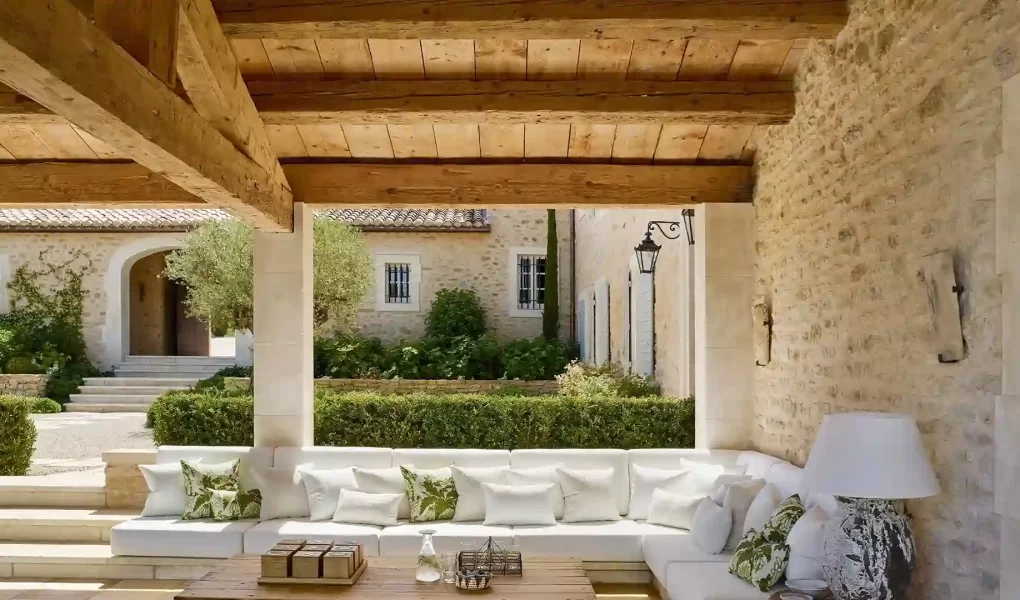Provencal interior design, also known as French Country or Provence style, embodies the essence of the picturesque and tranquil region of Provence in southeastern France. This design aesthetic captures the region’s natural beauty, rich history, and rustic charm, creating a warm and inviting atmosphere. In this article, we will delve into the key elements of Provencal interior design, exploring its origins, characteristics, color palette, furniture, textiles, and how to incorporate this timeless style into your home.
Origins of Provencal Interior Design

Historical Background
The Provencal style originates from the Provence region, renowned for its lavender fields, olive groves, and charming villages. The design reflects the lifestyle and traditions of rural France, where simplicity, practicality, and a connection to nature are paramount. It draws inspiration from French farmhouses and cottages, incorporating elements that are both elegant and rustic.
Influences
Provencal interior design is influenced by several factors, including the Mediterranean climate, the region’s agricultural heritage, and the craftsmanship of local artisans. The style combines rustic elements with refined touches, reflecting the balance between the humble rural life and the sophistication of French culture.
Key Characteristics of Provencal Interior Design
Color Palette
Soft and Muted Tones
The color palette of Provencal interior design is inspired by the natural surroundings of Provence. Soft, muted tones dominate the scheme, creating a serene and soothing atmosphere. Common colors include:
- Whites and Creams: These colors form the base of the palette, providing a neutral backdrop that enhances the light and airy feel of the space.
- Pastel Shades: Light blues, pinks, and greens are often used to add subtle color accents without overpowering the overall design.
- Warm Earthy Hues: Warm yellows, terracotta, and ochre evoke the sun-drenched landscapes and rustic charm of the region.
Natural Materials and Finishes
Natural materials play a crucial role in Provencal design. Stone, wood, and wrought iron are commonly used, adding texture and authenticity to the space. These materials are often left in their natural state or lightly treated to maintain their original beauty.
Furniture
Antique and Distressed Pieces
Furniture in Provencal interior design is characterized by its antique and distressed appearance. Vintage and heirloom pieces are prized for their history and craftsmanship. Key furniture items include:
- Farmhouse Tables: Large wooden tables with a weathered finish serve as the heart of the home, perfect for family gatherings and meals.
- Armoires and Cabinets: These storage pieces are often ornately carved and feature distressed paint or natural wood finishes.
- Upholstered Chairs and Sofas: Comfortable seating with soft, worn fabrics like linen or cotton in muted tones adds to the cozy feel.
Elegant Details
While the overall aesthetic is rustic, Provencal furniture often features elegant details such as curved legs, intricate carvings, and delicate hardware. These elements add a touch of sophistication to the otherwise simple and practical designs.
Textiles and Patterns
Natural Fabrics
Textiles in Provencal interior design are typically made from natural fibers like linen, cotton, and wool. These fabrics are chosen for their durability and comfort, enhancing the relaxed and welcoming ambiance of the space.
Floral and Botanical Patterns
Floral and botanical patterns are a hallmark of Provencal design. These motifs reflect the region’s abundant flora and add a touch of nature to the interior. Common patterns include:
- Lavender and Olive Branches: These iconic Provencal plants are often depicted in soft, watercolor-like prints.
- Toile de Jouy: A classic French pattern featuring pastoral scenes, often in blue or red on a white background, adds a traditional and romantic touch.
Incorporating Provencal Design into Your Home
Creating a Provencal-Inspired Living Room
Furniture Arrangement
Arrange furniture to create a cozy and inviting seating area. A large, comfortable sofa with linen upholstery, paired with vintage armchairs and a rustic coffee table, sets the stage for a Provencal living room. Add a distressed wood armoire or cabinet for storage and display.
Decorative Elements
Incorporate decorative elements such as wrought iron candle holders, ceramic vases filled with fresh or dried flowers, and woven baskets. These accessories add texture and warmth to the space, enhancing the Provencal ambiance.
Designing a Provencal Kitchen
Farmhouse Style
A Provencal kitchen embraces the farmhouse style with open shelving, wooden countertops, and a large farmhouse sink. Use natural materials like stone or terracotta for the flooring and backsplash.
Rustic Charm
Add rustic charm with vintage kitchenware, enamel pots, and copper utensils. Display these items openly on shelves or hang them from hooks for easy access and a lived-in feel.
Crafting a Provencal Bedroom
Soft and Serene
Create a serene bedroom with a soft color palette of whites, creams, and pastel shades. Choose an antique or distressed wooden bed frame and complement it with linen bedding and a quilted throw.
Personal Touches
Add personal touches with vintage bedside tables, a wrought iron chandelier, and floral-patterned curtains. A bouquet of fresh lavender on the nightstand adds a quintessential Provencal touch.
Enhancing Outdoor Spaces
Provence-Inspired Garden
Extend the Provencal style to your outdoor spaces by creating a garden inspired by the region. Plant lavender, rosemary, and other aromatic herbs. Use terracotta pots and wrought iron furniture to enhance the rustic charm.
Al Fresco Dining
Set up an al fresco dining area with a wooden table and chairs. Add a linen tablecloth, vintage lanterns, and simple tableware for a relaxed and inviting outdoor dining experience.




